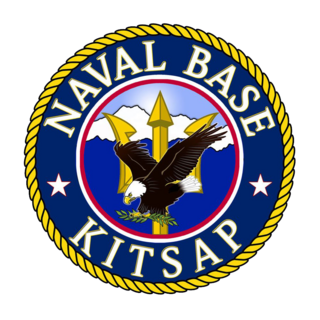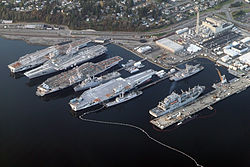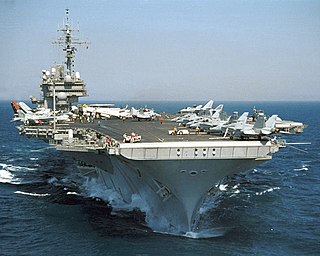Puget Sound Naval Shipyard | |
Four decommissioned aircraft carriers docked at the shipyard. From left: Independence, Kitty Hawk, Constellation, and Ranger. | |
| Location | N shore of Sinclair Inlet, Bremerton, WA |
|---|---|
| Coordinates | 47°33′31″N122°38′39″W / 47.5585°N 122.6442°W Coordinates: 47°33′31″N122°38′39″W / 47.5585°N 122.6442°W |
| Architect | US Navy |
| NRHP reference # | 92001883 |
| Significant dates | |
| Added to NRHP | 27 August 1992 [1] |
| Designated NHLD | 27 August 1992 [2] |
| Puget Sound Naval Shipyard and Intermediate Maintenance Facility | |
|---|---|
| Puget Sound, Washington | |
| Type | Shipyard |
| Site information | |
| Controlled by | United States Navy |
| Site history | |
| Built | 1891 |
| In use | 1891–present |
Puget Sound Naval Shipyard and Intermediate Maintenance Facility (PSNS & IMF) is a United States Navy shipyard covering 179 acres (0.7 km²) on Puget Sound at Bremerton, Washington in uninterrupted use since its establishment in 1891; it has also been known as Navy Yard Puget Sound, Bremerton Navy Yard, and Puget Sound Naval Shipyard.

The United States Navy (USN) is the naval warfare service branch of the United States Armed Forces and one of the seven uniformed services of the United States. It is the largest and most capable navy in the world and it has been estimated that in terms of tonnage of its active battle fleet alone, it is larger than the next 13 navies combined, which includes 11 U.S. allies or partner nations. with the highest combined battle fleet tonnage and the world's largest aircraft carrier fleet, with eleven in service, and two new carriers under construction. With 319,421 personnel on active duty and 99,616 in the Ready Reserve, the Navy is the third largest of the service branches. It has 282 deployable combat vessels and more than 3,700 operational aircraft as of March 2018, making it the second-largest air force in the world, after the United States Air Force.

A shipyard is a place where ships are built and repaired. These can be yachts, military vessels, cruise liners or other cargo or passenger ships. Dockyards are sometimes more associated with maintenance and basing activities than shipyards, which are sometimes associated more with initial construction. The terms are routinely used interchangeably, in part because the evolution of dockyards and shipyards has often caused them to change or merge roles.

Puget Sound is a sound along the northwestern coast of the U.S. state of Washington, an inlet of the Pacific Ocean, and part of the Salish Sea. It is a complex estuarine system of interconnected marine waterways and basins, with one major and two minor connections to the open Pacific Ocean via the Strait of Juan de Fuca—Admiralty Inlet being the major connection and Deception Pass and Swinomish Channel being the minor.
Contents
- History
- Installations
- Ship-Submarine Recycling Program
- Mothball Fleet
- Environmental Issues
- Gallery
- Puget Sound Naval Shipyard Historic Districts
- See also
- Notes
- External links
It is bordered on the south by Sinclair Inlet, on the west by the Bremerton Annex of Naval Base Kitsap, and on the north and east by the city of Bremerton, Washington. It is the Pacific Northwest's largest naval shore facility and one of Washington state's largest industrial installations. PSNS & IMF provides the Navy with maintenance, modernization, and technical and logistics support.

Sinclair Inlet is an arm of Puget Sound in Kitsap County, Washington, USA. It is the southwestern extension of Port Orchard, and it touches the shores of three of Kitsap County's four incorporated cities: Bremerton, Bainbridge Island, and Port Orchard. It is connected to Dyes Inlet by the Port Washington Narrows and to Puget Sound by Rich Passage. It was named by United States Navy explorer Charles Wilkes for George T. Sinclair, acting master of one of his ship's crews.

Naval Base Kitsap is a U.S. Navy base located on the Kitsap Peninsula in Washington state. It was created in 2004 by merging the former Naval Station Bremerton with Naval Submarine Base Bangor. The Mission of Naval Base Kitsap is to serve as the home base for the Navy’s fleet throughout West Puget Sound and to provide base operating services, including support for both surface ships and Fleet Ballistic Missile and other nuclear submarines having their home ports at Bremerton and Bangor.

The Pacific Northwest (PNW), sometimes referred to as Cascadia, is a geographic region in western North America bounded by the Pacific Ocean to the west and (loosely) by the Cascade Mountain Range on the east. Though no official boundary exists, the most common conception includes the Canadian province of British Columbia (BC) and the U.S. states of Idaho, Oregon, and Washington. Broader conceptions reach north into Southeast Alaska and Yukon, south into northern California, and east to the Continental Divide to include Western Montana and parts of Wyoming. Narrower conceptions may be limited to the coastal areas west of the Cascade and Coast mountains. The variety of definitions can be attributed to partially overlapping commonalities of the region's history, culture, geography, society, and other factors.































